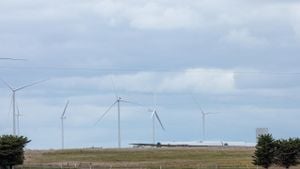Inflation has been making headlines worldwide, prompting discussions about its causes and how to manage its impact on global economies. The Reserve Bank of India (RBI) is at the forefront of this conversation. Shaktikanta Das, the RBI Governor, recently expressed concerns over the potential return of global inflation during his address at CNBC-TV18's Global Leadership Summit held in Mumbai. His remarks, delivered from the stage, carried weight as he discussed the delicate balance central banks must maintain between fostering economic growth and controlling inflation.
Das acknowledged the successful navigation through challenging economic waters, crediting monetary policy for preventing what he termed "a soft landing." Yet, he didn't shy away from stating the challenges still lurking around the corner—namely, inflation risks and the possibility of economic growth slowing down. Despite the progress made, the Governor cautioned, "Government bond yields are rising even as many advanced economies have embarked upon an easing path through rate cuts." He emphasized the multifaceted nature of these influences, hailing from both global and domestic factors.
These external pressures include not only geopolitical conflicts but also the effects of commodity price volatility and the impacts of climate change. Observing the trends, Das pointed out how even the performance of the U.S. dollar—which has seen increases against other currencies—is part of the complex picture. Investors are concerned about the currency’s strength tied to rising interest rates, which could complicate the Federal Reserve's plans to lower rates.
Simultaneously, the global economic environment is not solely dictated by the U.S. Federal Reserve's movements. Das illustrated this by noting rising tensions tied to geopolitical strategies and the geopolitical fragmentation of the global economic system. He painted a picture where nations increasingly positioned themselves within distinct economic blocks—Western, Eastern, and neutral—have led to significant shifts in foreign direct investment (FDI) patterns.
A recent study introduced a novel index illustrating these shifts. Researchers Lukas Boeckelmann, Isabella Moder, and Tajda Spital provided insights on how these geopolitical divides have directly influenced global FDI flows. Their findings revealed sobering statistics; investments across geopolitical lines—and even within adjacent blocs—have witnessed debilitating decreases, often by two-thirds.
The key takeaway here is the observation of how interconnected economies are still subjected to the fissures created by international politics. This fragmentation isn't just about shifts between superpowers like the U.S. and China. Small and medium economies are feeling the weight as larger geopolitical forces dictate their economic fate. The investment climate grows less welcoming, especially for nations caught between competing interests of powerful blocs.
Meanwhile, as global investors and economists process these alarming trends, the situation continually demands vigilance. Key leaders are communicating the need for not just reactive measures, but proactive policies. Goyal, India’s Union Minister of Commerce, highlighted the need for monetary policy adjustments to stimulate growth amid these shifting sands. He argued for interest rate cuts to keep the country's economy—the fastest-growing major economy—on track.
Das, for his part, opted for caution, refraining from commenting on imminent policy changes until after the next review. This keeps the markets on their toes, where anticipation itself drives speculation and strategies.
Despite the fragmented investment picture, Das concluded on somewhat of an optimistic note: amid higher volatility and increased geopolitical tensions, global trade is projected to remain elevated this year compared to the previous year. This resilience speaks to the underlying strength of many economies even as they navigate these turbulent waters—a blend of cautious optimism tempered with the realities of geopolitics.
Now, as countries wrestle with their economic composition, each featuring its unique inflationary pressures, the ripple effects of global financial decision-making will likely continue. This situation creates new dynamics for both policymakers and investors. The challenge lies not only with managing local inflation but also with considering the broader impacts of international investment flows and geopolitical stability.
Global stakeholders—governments, financial institutions, and corporations—must grapple with the realities of this increasingly interconnected and fragmented world. This includes adapting to economic signals and recognizing the interdependencies created by global trade dynamics, inflation, and sociopolitical environments.
For many, it may feel like walking on eggshells as they balance between fostering growth and combating inflation, but these discussions are more necessary now than ever. Active voices like Das and Goyal represent the growing recognition of the interplay between national policies and global market conditions—a narrative shaping the economic future.
This is where the essence of future fiscal policy will likely play out, as nations find their footing amid uncertainty. It’s not just about safeguarding economic health; it’s about forging pathways through one of the most complex financial landscapes seen to date.



